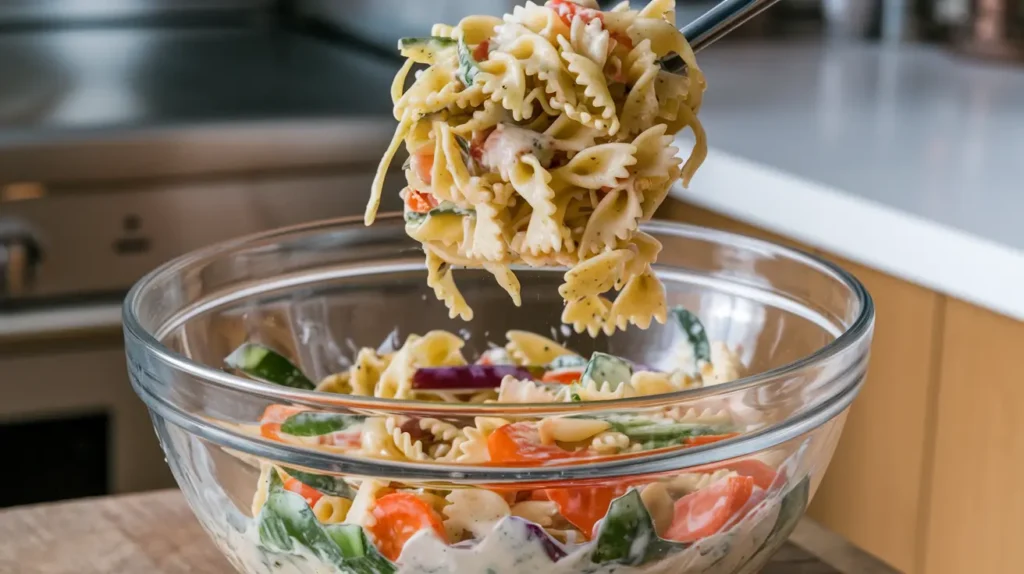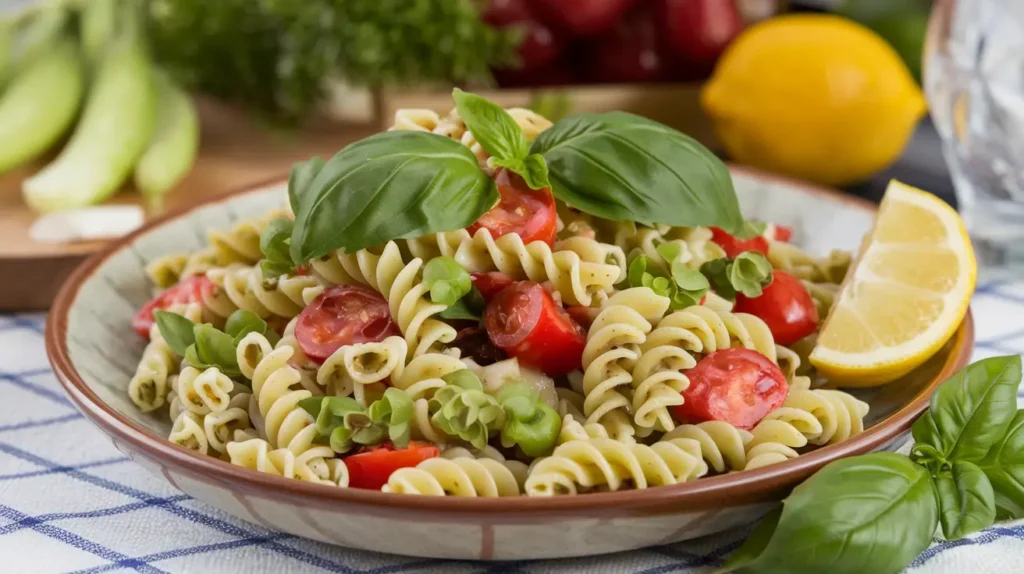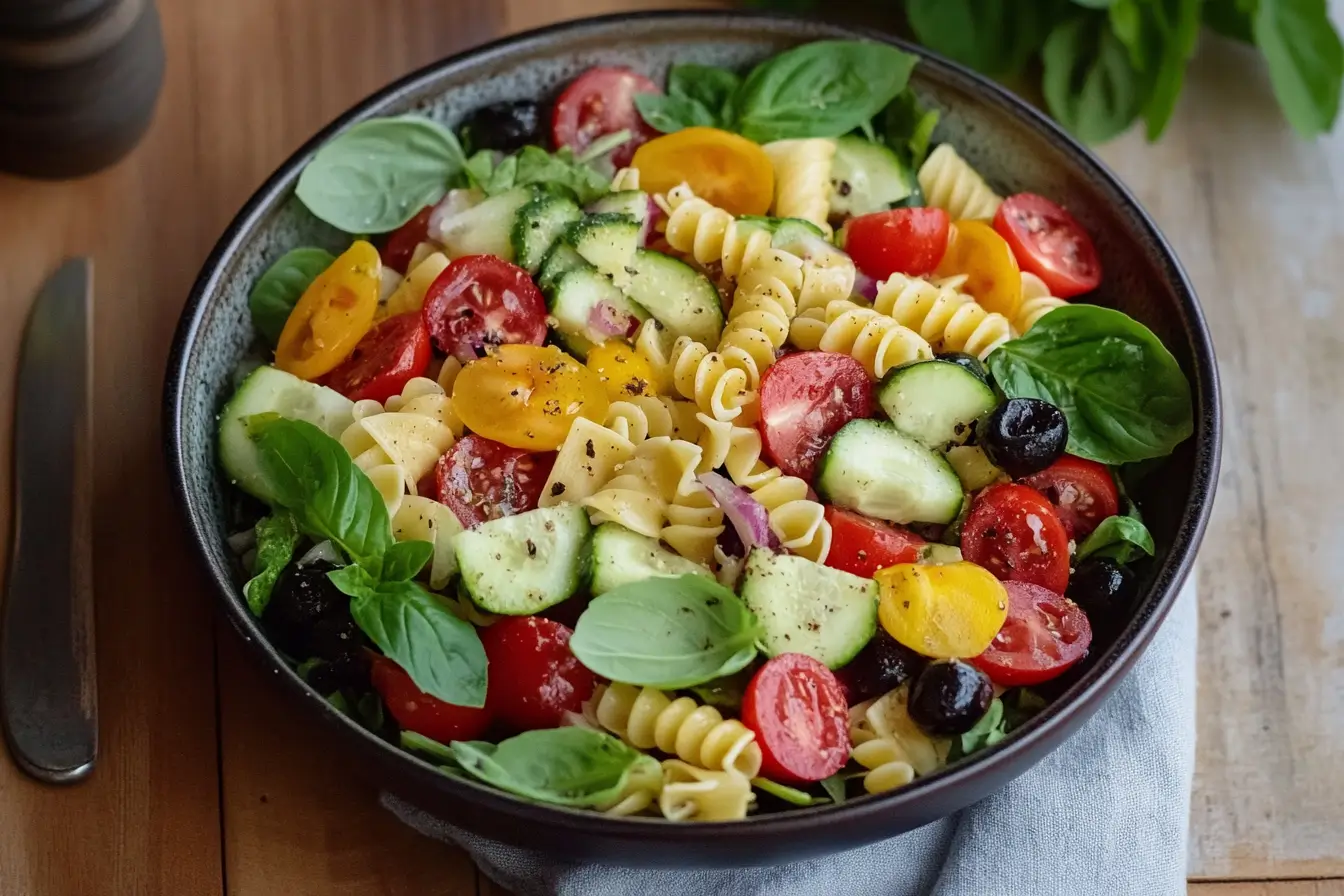Table of Contents
Gluten-free pasta salad is a culinary gem that caters to diverse dietary needs while packing flavor, nutrition, and versatility into every bite. Whether you’re avoiding gluten due to celiac disease or simply exploring new food trends, this dish offers an inclusive and satisfying solution. From choosing the right gluten-free pasta to mastering preparation techniques, this guide dives into everything you need to create the perfect gluten-free pasta salad. You’ll find tips, tricks, and delicious recipes that ensure your dish is both appetizing and dietary-friendly. Ready to uncover the secrets? Let’s get started!
What Is Gluten-Free Pasta Salad?
An Overview of Gluten-Free Pasta Salad
Gluten-free pasta salad is a delightful mix of gluten-free pasta, fresh vegetables, proteins, and dressings that comes together to form a colorful and flavorful dish. It’s a crowd-pleaser for picnics, potlucks, and quick lunches. Unlike traditional pasta salads, which rely on wheat-based noodles, this variation uses pasta made from gluten-free ingredients such as rice, quinoa, or legumes. Not only does this substitution make it safe for those with gluten sensitivities, but it also opens the door to an array of textures and tastes.
This dish is more than just a dietary alternative—it’s a celebration of creativity in the kitchen. The lack of gluten doesn’t limit the flavor; in fact, it enhances it with the incorporation of nutrient-rich ingredients and vibrant dressings. So, whether you’re preparing it for a summer gathering or a quick family meal, gluten-free pasta salad is as versatile as it is nutritious.
Why Choose Gluten-Free Pasta Salad?
There are several reasons why a gluten-free pasta salad might become your go-to dish:
- Health Benefits: Gluten-free pasta ensures your salad is celiac-safe while offering alternatives often rich in protein and fiber.
- Dietary Flexibility: With gluten-free noodles, this salad accommodates varied dietary restrictions, making it ideal for diverse gatherings.
- Creative Potential: From bold vinaigrettes to creamy dressings, you can easily tweak flavors to suit your preferences.
The appeal of gluten-free pasta salad lies in its ability to bring together people with different food needs while retaining its charm and taste. And when made right, this dish is as comforting as it is inclusive.
Ingredients and Preparation
Selecting the Right Gluten-Free Pasta
When crafting the perfect gluten-free pasta salad, the pasta you choose sets the stage. Not all gluten-free pastas are created equal, and selecting one that complements the dish is key to nailing the texture and flavor.
- Rice-Based Pasta: A popular choice for salads due to its neutral flavor and firm bite. It’s less likely to break apart during mixing.
- Corn-Based Pasta: Offers a slight sweetness and sturdy texture that works well for cold dishes.
- Legume-Based Pasta: Options like chickpea or lentil pasta add a protein punch but may be denser, so they’re best paired with robust ingredients and dressings.
- Quinoa Pasta: A balanced choice that combines good texture with a mild, nutty flavor.
Pro Tip: Experiment with different types to find your favorite. Cooking times and textures vary, so always follow package instructions closely.
Essential Ingredients for a Flavorful Gluten-Free Pasta Salad
A standout pasta salad combines a symphony of textures and tastes. Here’s what to include:
- Fresh Vegetables: Tomatoes, cucumbers, bell peppers, and red onions add crunch and color.
- Proteins: Grilled chicken, tofu, or chickpeas work wonders to make the salad hearty.
- Cheeses: Feta, mozzarella pearls, or shredded Parmesan can add creamy and tangy elements.
- Dressings: Opt for a tangy vinaigrette or a creamy, dairy-free option for flavor cohesion.
- Crunchy Additions: Seeds, nuts, or gluten-free croutons provide texture contrast.
Don’t skimp on freshness! Vegetables and herbs should be at their peak for the best results.
Step-by-Step Preparation Guide

Making a gluten-free pasta salad is easier than you might think. Here’s how to ensure your dish turns out perfectly every time:
- Cook the Pasta:
- Boil gluten-free pasta in a large pot of salted water.
- Test for doneness a minute before the recommended cooking time to avoid overcooking.
- Drain and rinse with cold water to stop the cooking process and prevent stickiness.
- Prepare the Add-Ins:
- Dice vegetables into bite-sized pieces for even distribution.
- Cook proteins like chicken or tofu if you’re using them.
- Mix the Salad:
- In a large bowl, combine the cooled pasta, vegetables, proteins, and cheese.
- Pour the dressing over and toss gently to coat every piece evenly.
- Chill Before Serving:
- Refrigerate for at least 30 minutes to let the flavors meld.
Cooking gluten-free pasta may seem tricky due to its tendency to overcook or stick, but with the right approach, you’ll get a perfectly balanced dish. Use ample water and keep an eye on the texture for the best results.
Using the Right Dressing for Gluten-Free Pasta Salad
The dressing can make or break a pasta salad. Whether you prefer a zesty Italian vinaigrette or a creamy avocado-based dressing, ensure it complements the other ingredients. A splash of lemon juice or apple cider vinegar can elevate the flavor profile even further.
Marinating Tip: Tossing warm pasta with a small portion of the dressing lets it soak up more flavor before mixing it with the other ingredients.
Tips and Tricks for the Perfect Gluten-Free Pasta Salad
Cooking Gluten-Free Pasta to Perfection
One of the most common challenges in making gluten-free pasta salad is getting the texture just right. Gluten-free pasta can quickly go from perfect to mushy if you’re not careful, but these tips can help:
- Use Plenty of Water: Gluten-free pasta releases more starch than traditional varieties, so using a large pot with ample water prevents stickiness.
- Add Salt Generously: Seasoning the water well enhances the flavor of the pasta itself.
- Stir Frequently: To avoid clumping, stir the pasta several times during cooking, especially at the beginning.
- Check for Al Dente: Gluten-free pasta has a narrow window for achieving the right texture. Start testing a minute or two before the recommended cooking time.
- Rinse After Draining: A quick rinse with cold water halts the cooking process and removes excess starch, ensuring your pasta stays firm.
Following these tips ensures that your gluten-free pasta is the ideal base for a delicious salad.
Common Mistakes to Avoid
Creating a flavorful gluten-free pasta salad is all about the details. Avoid these pitfalls to keep your dish fresh and appetizing:
- Overcooking the Pasta: Mushy pasta ruins the salad’s texture. Always aim for al dente.
- Skipping the Rinse: Failing to rinse your pasta leaves excess starch, making the salad gummy.
- Under-Seasoning: Gluten-free pasta can be bland on its own, so season the water and use a flavorful dressing.
- Preparing Too Far in Advance: Gluten-free pasta can harden if refrigerated for too long. Assemble the salad close to serving time for the best texture.
- Overloading Ingredients: Too many components can overwhelm the pasta and dressing, leaving the dish unbalanced.
By sidestepping these mistakes, your pasta salad will maintain its texture and flavor, ensuring rave reviews every time.
Enhancing Flavor and Texture

Want your gluten-free pasta salad to stand out? Here are some easy ways to elevate it:
- Marinate the Pasta: Toss warm pasta with a portion of the dressing before adding other ingredients to infuse it with flavor.
- Incorporate Fresh Herbs: Basil, parsley, or cilantro add a burst of freshness that complements the salad.
- Add a Crunch Factor: Toasted nuts, seeds, or gluten-free croutons provide delightful textural contrast.
- Use High-Quality Ingredients: Opt for fresh vegetables, extra virgin olive oil, and freshly grated cheese for the best results.
- Balance the Flavors: Include a mix of tangy, salty, and sweet components. For instance, a touch of honey or maple syrup in the dressing can balance acidic elements like vinegar.
These tricks will transform your gluten-free pasta salad from ordinary to extraordinary!
Popular Gluten-Free Pasta Salad Recipes
Classic Italian Gluten-Free Pasta Salad
A timeless favorite, the Italian gluten-free pasta salad combines fresh vegetables, zesty dressing, and a medley of flavors reminiscent of a Mediterranean feast.
Ingredients:
- Gluten-free fusilli pasta
- Cherry tomatoes, halved
- Sliced black olives
- Diced cucumbers
- Red onion, thinly sliced
- Fresh basil leaves
- Italian vinaigrette (olive oil, red wine vinegar, minced garlic, oregano, and a pinch of sugar)
- Parmesan cheese (optional)
Instructions:
- Cook the pasta to al dente, rinse, and cool.
- In a large bowl, toss pasta with tomatoes, olives, cucumbers, onion, and basil.
- Drizzle with Italian vinaigrette and toss gently.
- Top with grated Parmesan if desired and refrigerate for 30 minutes before serving.
This salad is perfect for outdoor gatherings or as a light, refreshing lunch.
Creamy Avocado Gluten-Free Pasta Salad
For those who prefer a creamy twist, this avocado-based pasta salad is both nutritious and indulgent.
Ingredients:
- Gluten-free penne pasta
- Ripe avocados
- Fresh lime juice
- Greek yogurt (or a dairy-free alternative)
- Minced garlic
- Sweet corn (cooked and cooled)
- Diced red bell pepper
- Cilantro leaves
Instructions:
- Blend avocados, lime juice, yogurt, and garlic until smooth to create the dressing.
- Cook the pasta, rinse, and cool.
- In a bowl, mix pasta, corn, bell peppers, and cilantro.
- Pour the avocado dressing over the salad and toss until well-coated.
This salad’s creamy texture pairs wonderfully with the crisp crunch of fresh vegetables.
Southwestern Gluten-Free Pasta Salad
For a bold and spicy flavor, this Southwestern-inspired recipe features robust spices and hearty ingredients.
Ingredients:
- Gluten-free rotini pasta
- Black beans, rinsed and drained
- Sweet corn kernels
- Cherry tomatoes, halved
- Red onion, finely chopped
- Cilantro leaves
- Lime-cumin vinaigrette (lime juice, olive oil, ground cumin, chili powder, and a touch of honey)
Instructions:
- Cook the pasta, rinse, and set aside.
- Combine pasta with black beans, corn, tomatoes, onion, and cilantro in a large bowl.
- Whisk together the lime-cumin vinaigrette and pour over the salad. Toss to coat evenly.
- Chill before serving to let the flavors meld.
This hearty dish is perfect for those who enjoy a little spice in their meals.
Greek-Style Gluten-Free Pasta Salad
This recipe captures the flavors of Greece with a combination of olives, feta, and a tangy lemon dressing.
Ingredients:
- Gluten-free bowtie pasta
- Kalamata olives
- Diced cucumber
- Cherry tomatoes
- Crumbled feta cheese
- Lemon-olive oil dressing (lemon juice, olive oil, Dijon mustard, and oregano)
- Fresh dill
Instructions:
- Cook and cool the pasta as directed.
- Mix pasta with olives, cucumber, tomatoes, and dill in a large serving bowl.
- Drizzle with the lemon-olive oil dressing and toss gently.
- Sprinkle with feta before serving.
This dish is light, tangy, and perfect for summer picnics.
Serving and Styling Gluten-Free Pasta Salad
Creative Ways to Serve Gluten-Free Pasta Salad
Presentation can elevate even the simplest dishes, and gluten-free pasta salad is no exception. Here are some creative serving ideas to wow your guests:
- Individual Portions: Serve pasta salad in small glass jars or cups for a grab-and-go option at parties or picnics. This adds a personal touch and keeps portions neat.
- Layered Salad Bowls: Arrange ingredients in visible layers in a clear serving bowl. This works particularly well for colorful salads like Greek or Southwestern styles.
- Garnished Platters: Present the salad on a large platter and garnish with fresh herbs, lemon wedges, or toasted seeds for a rustic, eye-catching look.
- Leafy Beds: Serve pasta salad over a bed of greens such as arugula, spinach, or romaine to add a fresh twist and more visual appeal.
Tips for Perfect Presentation
- Color Coordination: Use a variety of vegetables with different colors to create a visually vibrant dish. Ingredients like cherry tomatoes, bell peppers, and purple onions can brighten the plate.
- Fresh Garnishes: Sprinkle fresh herbs like basil, parsley, or dill over the salad just before serving for a professional touch.
- Choose the Right Serving Dish: A large white bowl or platter allows the colors of the salad to pop, while rustic wooden bowls can create a cozy, natural aesthetic.
- Season Strategically: A final drizzle of olive oil or a dusting of freshly cracked pepper can give the dish a polished finish.
Pairing Ideas for Gluten-Free Pasta Salad
Pasta salad is a versatile dish that pairs beautifully with a variety of other foods. Consider serving it with:
- Grilled Proteins: Chicken, fish, or tofu complements the light, fresh flavors of pasta salad.
- Roasted Vegetables: A side of roasted asparagus, zucchini, or carrots adds an earthy dimension to the meal.
- Gluten-Free Bread: A slice of gluten-free focaccia or a warm roll can round out the dish.
Proper presentation makes your gluten-free pasta salad not only taste great but also look irresistible. A beautifully styled salad is sure to impress at any gathering!
Adapting Gluten-Free Pasta Salad for Different Needs
Customizing Gluten-Free Pasta Salad for Special Diets
One of the best things about gluten-free pasta salad is how easily it can be adapted to suit various dietary preferences and restrictions. Here’s how you can modify it for different needs:
- Dairy-Free Version:
Replace cheeses like feta or Parmesan with dairy-free alternatives or add avocado for creaminess. Opt for a vinaigrette-based dressing instead of creamy ones. - Vegan-Friendly:
Skip animal proteins and dairy. Use plant-based proteins such as chickpeas, lentils, or tofu. Nutritional yeast can provide a cheesy flavor without using actual cheese. - Low-Carb Option:
Use spiralized zucchini, cucumber noodles, or shirataki pasta in place of traditional gluten-free pasta for a lower-carb alternative. - Nut-Free Adaptations:
Skip nuts and seeds if serving to someone with a nut allergy. Substitute with crunchy elements like crispy chickpeas or pumpkin seeds.
Adapting your pasta salad ensures everyone can enjoy the dish without compromising their dietary needs or preferences.
Gluten-Free Pasta Salad for Different Occasions
From casual lunches to festive gatherings, this versatile dish shines in a variety of settings:
- Family Meals: Pair it with grilled chicken or roasted veggies for a complete dinner.
- Picnics and Potlucks: The portability and make-ahead nature of gluten-free pasta salad make it a favorite for outdoor events.
- Holiday Gatherings: Add festive ingredients like pomegranate seeds or roasted squash for a seasonal twist.
- Meal Prep: Prepare it in bulk for easy weekday lunches. Store portions in airtight containers to maintain freshness.
Expert Advice for Long-Lasting Freshness
Storing gluten-free pasta salad correctly helps maintain its flavor and texture:
- Keep Dressing Separate: If you’re prepping ahead, store the dressing separately and mix it in just before serving to avoid sogginess.
- Refrigerate Promptly: Store the salad in an airtight container in the fridge to keep it fresh for up to 3 days.
- Refresh Before Serving: Add a little extra dressing or olive oil before serving to rejuvenate the salad, especially if it has been refrigerated for some time.
Conclusion
Gluten-free pasta salad is more than just a dietary alternative; it’s a celebration of bold flavors, vibrant textures, and creative possibilities. From choosing the perfect pasta to customizing it for special diets and occasions, this dish proves that being gluten-free doesn’t mean sacrificing taste or variety. With this comprehensive guide, you’re now equipped to create a pasta salad that’s not only delicious but also adaptable and inclusive.
So go ahead, toss up your perfect gluten-free pasta salad and let it steal the spotlight at your next gathering!
Frequently Asked Questions About Gluten-Free Pasta Salad
Can gluten-free pasta be eaten cold?
Yes, gluten-free pasta can absolutely be eaten cold! In fact, it works perfectly in dishes like pasta salad. After cooking, rinse the pasta thoroughly with cold water to stop the cooking process and prevent it from becoming sticky. Then, toss it with your choice of dressing and ingredients. The key to enjoying cold gluten-free pasta is proper preparation, as it tends to firm up slightly when chilled. Adding extra dressing or letting it sit at room temperature for a few minutes before serving can improve its texture.
What’s the trick to cooking gluten-free pasta?
The trick lies in precision and attention to detail:
- Use plenty of water to dilute the starch released during cooking.
- Stir frequently, especially in the first few minutes, to prevent sticking.
- Test for doneness a minute or two before the suggested cooking time to achieve the ideal texture.
- Once cooked, drain immediately and rinse with cold water to halt the cooking process and wash away excess starch.
- Toss the pasta in a small amount of dressing or olive oil while it’s still warm to keep it moist and flavorful.
What are the five mistakes to avoid with pasta salad?
- Overcooking the Pasta: Gluten-free pasta gets mushy quickly; always cook it al dente.
- Skipping the Rinse: Failing to rinse leaves starch, which can cause clumping.
- Underdressing the Salad: Gluten-free pasta absorbs dressing more than wheat-based pasta, so use extra to maintain flavor.
- Ignoring Balance: Overloading ingredients or skipping key elements like crunch or acidity can create an unbalanced dish.
- Making It Too Early: Gluten-free pasta hardens in the fridge over time, so prepare the salad close to serving time for optimal texture.
What is the most popular gluten-free pasta?
The most popular gluten-free pasta brands include:
- Jovial Foods: Known for its high-quality, organic, gluten-free pasta made from brown rice.
- Barilla Gluten Free: A widely available option with great taste and texture in various shapes.
- Tinkyada: Offers rice-based pasta that’s firm and works wonderfully in salads.
Each brand offers unique textures and flavors, making them favorites among those who enjoy gluten-free pasta dishes.

